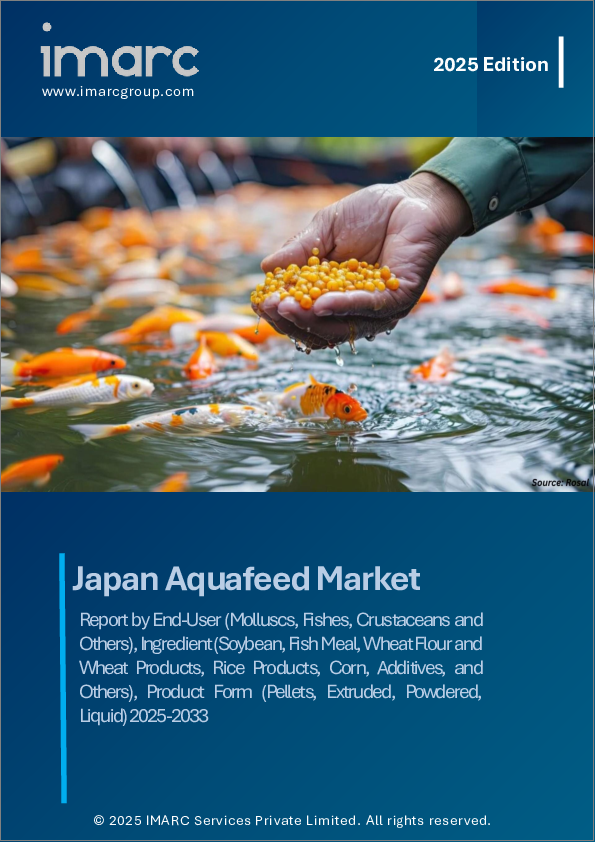|
|
市場調査レポート
商品コード
1729470
日本の水産飼料市場レポート:エンドユーザー、原料、製品形態別、2025年~2033年Japan Aquafeed Market Report by End-User, Ingredient, Product Form 2025-2033 |
||||||
カスタマイズ可能
|
|||||||
| 日本の水産飼料市場レポート:エンドユーザー、原料、製品形態別、2025年~2033年 |
|
出版日: 2025年05月01日
発行: IMARC
ページ情報: 英文 119 Pages
納期: 5~7営業日
|
全表示
- 概要
- 図表
- 目次
2024年の日本の水産飼料の市場規模は360万トンに達しました。今後、IMARC Groupは、市場は2033年までに660万トンに達し、2025年から2033年にかけて6.8%の成長率(CAGR)を示すと予測しています。
本レポートで扱う主な質問
- 日本の水産飼料市場のこれまでの推移と今後の推移は?
- 日本の水産飼料市場のエンドユーザー別区分は?
- 日本の水産飼料市場の成分区分は?
- 日本の水産飼料市場の製品形態による区分は?
- 日本の水産飼料市場のバリューチェーンにおける様々な段階とは?
- 日本の水産飼料市場の主な促進要因と課題は?
- 日本の水産飼料市場の構造と主要プレーヤーは?
- 日本の水産飼料市場における競合の程度は?
目次
第1章 序文
第2章 調査範囲と調査手法
- 調査の目的
- ステークホルダー
- データソース
- 市場推定
- 調査手法
第3章 エグゼクティブサマリー
第4章 イントロダクション
- 概要
- 主要業界動向
第5章 日本の水産飼料市場
- 市場概要
- 市場実績
- 市場内訳:エンドユーザー別
- 市場内訳:材料別
- 市場内訳:製品形態別
- 市場予測
- SWOT分析
- バリューチェーン分析
- ポーターのファイブフォース分析
- 価格分析
第6章 市場内訳:エンドユーザー別
- 軟体動物
- 魚類
- 甲殻類およびその他
第7章 市場内訳:材料別
- 大豆
- 魚粉
- 小麦粉および小麦製品
- 米製品
- トウモロコシ
- 添加剤
- その他
第8章 市場内訳:製品形態別
- ペレット
- 押し出し
- 粉末
- 液体
第9章 競合情勢
- 市場構造
- 主要企業
- 主要企業のプロファイル
List of Figures
- Figure 1: Japan: Aquafeed Market: Major Drivers and Challenges
- Figure 2: Japan: Aquafeed Market: Production Volume (in Million Tons), 2019-2024
- Figure 3: Japan: Aquafeed Market: Breakup by End-User (in %), 2024
- Figure 4: Japan: Aquafeed Market: Breakup by Ingredient (in %), 2024
- Figure 5: Japan: Aquafeed Market: Breakup by Product Form (in %), 2024
- Figure 6: Japan: Aquafeed Market Forecast: Production Volume (in Million Tons), 2025-2033
- Figure 7: Japan: Aquafeed Market Industry: SWOT Analysis
- Figure 8: Japan: Aquafeed Market Industry: Value Chain Analysis
- Figure 9: Japan: Aquafeed Market Industry: Porter's Five Forces Analysis
- Figure 10: Japan: Aquafeed (Molluscs) Market: Production Volume (in '000 Tons), 2019 & 2024
- Figure 11: Japan: Aquafeed (Japanese Scallop) Market: Production Volume (in '000 Tons), 2019 & 2024
- Figure 12: Japan: Aquafeed (Japanese Scallop) Market Forecast: Production Volume (in '000 Tons), 2025-2033
- Figure 13: Japan: Aquafeed (Pacific Oyster) Market: Production Volume (in '000 Tons), 2019 & 2024
- Figure 14: Japan: Aquafeed (Pacific Oyster) Market Forecast: Production Volume (in '000 Tons), 2025-2033
- Figure 15: Japan: Aquafeed (Molluscs) Market Forecast: Production Volume (in '000 Tons), 2025-2033
- Figure 16: Japan: Aquafeed (Fishes) Market: Production Volume (in '000 Tons), 2019 & 2024
- Figure 17: Japan: Aquafeed (Yellowtail) Market: Production Volume (in '000 Tons), 2019 & 2024
- Figure 18: Japan: Aquafeed (Yellowtail) Market Forecast: Production Volume (in '000 Tons), 2025-2033
- Figure 19: Japan: Aquafeed (Red Seabream) Market: Production Volume (in '000 Tons), 2019 & 2024
- Figure 20: Japan: Aquafeed (Red Seabream) Market Forecast: Production Volume (in '000 Tons), 2025-2033
- Figure 21: Japan: Aquafeed (Grater Amberjack) Market: Production Volume (in '000 Tons), 2019 & 2024
- Figure 22: Japan: Aquafeed (Grater Amberjack) Market Forecast: Production Volume (in '000 Tons), 2025-2033
- Figure 23: Japan: Aquafeed (Bluefin Tuna) Market: Production Volume (in '000 Tons), 2019 & 2024
- Figure 24: Japan: Aquafeed (Bluefin Tuna) Market Forecast: Production Volume (in '000 Tons), 2025-2033
- Figure 25: Japan: Aquafeed (Others) Market: Production Volume (in '000 Tons), 2019 & 2024
- Figure 26: Japan: Aquafeed (Others) Market Forecast: Production Volume (in '000 Tons), 2025-2033
- Figure 27: Japan: Aquafeed (Fishes) Market Forecast: Production Volume (in '000 Tons), 2025-2033
- Figure 28: Japan: Aquafeed (Crustaceans and Others) Market: Production Volume (in '000 Tons), 2019 & 2024
- Figure 29: Japan: Aquafeed (Crustaceans and Others) Market Forecast: Production Volume (in '000 Tons), 2025-2033
- Figure 30: Japan: Aquafeed (Soybean) Market: Production Volume (in '000 Tons), 2019 & 2024
- Figure 31: Japan: Aquafeed (Soybean) Market Forecast: Production Volume (in '000 Tons), 2025-2033
- Figure 32: Japan: Aquafeed (Fish Meal) Market: Production Volume (in '000 Tons), 2019 & 2024
- Figure 33: Japan: Aquafeed (Fish Meal) Market Forecast: Production Volume (in '000 Tons), 2025-2033
- Figure 34: Japan: Aquafeed (Wheat Flour and Wheat Products) Market: Production Volume (in '000 Tons), 2019 & 2024
- Figure 35: Japan: Aquafeed (Wheat Flour and Wheat Products) Market Forecast: Production Volume (in '000 Tons), 2025-2033
- Figure 36: Japan: Aquafeed (Rice Products) Market: Production Volume (in '000 Tons), 2019 & 2024
- Figure 37: Japan: Aquafeed (Rice Products) Market Forecast: Production Volume (in '000 Tons), 2025-2033
- Figure 38: Japan: Aquafeed (Corn) Market: Production Volume (in '000 Tons), 2019 & 2024
- Figure 39: Japan: Aquafeed (Corn) Market Forecast: Production Volume (in '000 Tons), 2025-2033
- Figure 40: Japan: Aquafeed (Additives) Market: Production Volume (in '000 Tons), 2019 & 2024
- Figure 41: Japan: Additives (Vitamins and Minerals) Market: Production Volume (in '000 Tons), 2019 & 2024
- Figure 42: Japan: Additives (Vitamins and Minerals) Market Forecast: Production Volume (in '000 Tons), 2025-2033
- Figure 43: Japan: Additives (Amino Acids) Market: Production Volume (in '000 Tons), 2019 & 2024
- Figure 44: Japan: Additives (Amino Acids) Market Forecast: Production Volume (in '000 Tons), 2025-2033
- Figure 45: Japan: Additives (Feed Acidifiers) Market: Production Volume (in '000 Tons), 2019 & 2024
- Figure 46: Japan: Additives (Feed Acidifiers) Market Forecast: Production Volume (in '000 Tons), 2025-2033
- Figure 47: Japan: Additives (Antibiotics) Market: Production Volume (in '000 Tons), 2019 & 2024
- Figure 48: Japan: Additives (Antibiotics) Market Forecast: Production Volume (in '000 Tons), 2025-2033
- Figure 49: Japan: Additives (Others) Market: Production Volume (in '000 Tons), 2019 & 2024
- Figure 50: Japan: Additives (Others) Market Forecast: Production Volume (in '000 Tons), 2025-2033
- Figure 51: Japan: Aquafeed (Additives) Market Forecast: Production Volume (in '000 Tons), 2025-2033
- Figure 52: Japan: Aquafeed (Others) Market: Production Volume (in '000 Tons), 2019 & 2024
- Figure 53: Japan: Aquafeed (Others) Market Forecast: Production Volume (in '000 Tons), 2025-2033
- Figure 54: Japan: Aquafeed (Pellets) Market: Production Volume (in '000 Tons), 2019 & 2024
- Figure 55: Japan: Aquafeed (Pellets) Market Forecast: Production Volume (in '000 Tons), 2025-2033
- Figure 56: Japan: Aquafeed (Extruded) Market: Production Volume (in '000 Tons), 2019 & 2024
- Figure 57: Japan: Aquafeed (Extruded) Market Forecast: Production Volume (in '000 Tons), 2025-2033
- Figure 58: Japan: Aquafeed (Powdered) Market: Production Volume (in '000 Tons), 2019 & 2024
- Figure 59: Japan: Aquafeed (Powdered) Market Forecast: Production Volume (in '000 Tons), 2025-2033
- Figure 60: Japan: Aquafeed (Liquid) Market: Production Volume (in '000 Tons), 2019 & 2024
- Figure 61: Japan: Aquafeed (Liquid) Market Forecast: Production Volume (in '000 Tons), 2025-2033
List of Tables
- Table 1: Japan: Aquafeed Market: Key Industry Highlights, 2024 and 2033
- Table 2: Japan: Aquafeed Market Forecast: Breakup by End-User (in '000 Tons), 2025-2033
- Table 3: Japan: Aquafeed Market Forecast: Breakup by Molluscs Type (in '000 Tons), 2025-2033
- Table 4: Japan: Aquafeed Market Forecast: Breakup by Fish Type (in '000 Tons), 2025-2033
- Table 5: Japan: Aquafeed Market Forecast: Breakup by Ingredient (in '000 Tons), 2025-2033
- Table 6: Japan: Aquafeed Market Forecast: Breakup by Product Form (in '000 Tons), 2025-2033
- Table 7: Japan: Aquafeed Market Structure
- Table 8: Japan: Aquafeed Market: Key Players
The Japan aquafeed market size reached 3.6 Million Tons in 2024. Looking forward, IMARC Group expects the market to reach 6.6 Million Tons by 2033, exhibiting a growth rate (CAGR) of 6.8% during 2025-2033.
Aquafeed refers to the food specifically prepared for aquatic animals to fulfill their nutritional requirements. Japan is one of the largest mollusk producers which requires an enormous quantity of high-quality aquafeed and thus serving as a major growth driver of the aquafeed industry in the country.
The increasing seafood consumption in Japan coupled with the rising consumer awareness about the seafood health benefits, is escalating the demand for aquafeed in the region. In fact, the government's ongoing attempts to boost aquaculture output are further accelerating the aquafeed industry. For instance, Japan government launched a 'Fast Fish' campaign to encourage further modernization of country's fishing sector and increase the production of certified sustainable seafood. In addition to this, modern feed management techniques in Japan are also becoming responsible for high consumption of feed in the various farming sectors. Moreover, an increase in fish mass production, rising intensive farming, advancements in the stocking and feeding densities, feeding management practices are some of the other factors that have proliferated the market growth in the country.
Key Market Segmentation:
Breakup by End-User:
- Molluscs
- Japanese Scallop
- Pacific Oyster
- Fishes
- Yellowtail
- Red Seabream
- Grater Amberjack
- Bluefin Tuna
- Others
- Crustaceans and Others
Fishes currently represent the leading segment, holding the largest share.
Breakup by Ingredient:
- Soybean
- Fish Meal
- Wheat Flour and Wheat Products
- Rice Products
- Corn
- Additives
- Vitamins & Minerals
- Amino Acids
- Feed Acidifiers
- Antibiotics
- Others
- Others
Soybean currently dominates the market, holding majority of the market share.
Breakup by Product Form:
- Pellets
- Extruded
- Powdered
- Liquid
Amongst these, pellets account for the largest market share.
Competitive Landscape:
The report has also examined the competitive landscape of the Japan aquafeed market. Some of the major players include:
- Marubeni Nisshin Feed Co. Ltd.
- Nosan Corporation (Mitsubishi Corporation)
- Skretting (Nutreco N.V.)
Key Questions Answered in This Report:
- How has the Japan aquafeed market performed so far and how will it perform in the coming years?
- What is the breakup of the Japan aquafeed market based on the end-user?
- What is the breakup of the Japan aquafeed market based on the ingredient?
- What is the breakup of the Japan aquafeed market based on the product form?
- What are the various stages in the value chain of the Japan aquafeed market?
- What are the key driving factors and challenges in Japan aquafeed market?
- What is the structure of the Japan aquafeed market and who are the key players?
- What is the degree of competition in the Japan aquafeed market?
Table of Contents
1 Preface
2 Scope and Methodology
- 2.1 Objectives of the Study
- 2.2 Stakeholders
- 2.3 Data Sources
- 2.3.1 Primary Sources
- 2.3.2 Secondary Sources
- 2.4 Market Estimation
- 2.4.1 Bottom-Up Approach
- 2.4.2 Top-Down Approach
- 2.5 Forecasting Methodology
3 Executive Summary
4 Introduction
- 4.1 Overview
- 4.2 Key Industry Trends
5 Japan Aquafeed Market
- 5.1 Market Overview
- 5.2 Market Performance
- 5.3 Market Breakup by End-User
- 5.4 Market Breakup by Ingredient
- 5.5 Market Breakup by Product Form
- 5.6 Market Forecast
- 5.7 SWOT Analysis
- 5.7.1 Overview
- 5.7.2 Strengths
- 5.7.3 Weaknesses
- 5.7.4 Opportunities
- 5.7.5 Threats
- 5.8 Value Chain Analysis
- 5.8.1 Overview
- 5.8.2 Input Suppliers
- 5.8.3 Feed Manufacturers
- 5.8.4 Marketing
- 5.8.5 Distribution
- 5.8.6 Exports
- 5.8.7 End-Use
- 5.9 Porters Five Forces Analysis
- 5.9.1 Overview
- 5.9.2 Bargaining Power of Buyers
- 5.9.3 Bargaining Power of Suppliers
- 5.9.4 Degree of Competition
- 5.9.5 Threat of New Entrants
- 5.9.6 Threat of Substitutes
- 5.10 Price Analysis
- 5.10.1 Key Price Indicators
- 5.10.2 Price Structure
- 5.10.3 Margin Analysis
6 Market Breakup by End-User
- 6.1 Molluscs
- 6.1.1 Market Trends
- 6.1.2 Market Breakup by Molluscs Type
- 6.1.2.1 Japanese Scallop
- 6.1.2.1.1 Market Trends
- 6.1.2.1.2 Market Forecast
- 6.1.2.2 Pacific Oyster
- 6.1.2.2.1 Market Trends
- 6.1.2.2.2 Market Forecast
- 6.1.2.1 Japanese Scallop
- 6.1.3 Market Forecast
- 6.2 Fishes
- 6.2.1 Market Trends
- 6.2.2 Market Breakup by Fish Type
- 6.2.2.1 Yellowtail
- 6.2.2.1.1 Market Trends
- 6.2.2.1.2 Market Forecast
- 6.2.2.2 Red Seabream
- 6.2.2.2.1 Market Trends
- 6.2.2.2.2 Market Forecast
- 6.2.2.3 Grater Amberjack
- 6.2.2.3.1 Market Trends
- 6.2.2.3.2 Market Forecast
- 6.2.2.4 Bluefin Tuna
- 6.2.2.4.1 Market Trends
- 6.2.2.4.2 Market Forecast
- 6.2.2.5 Others
- 6.2.2.5.1 Market Trends
- 6.2.2.5.2 Market Forecast
- 6.2.2.1 Yellowtail
- 6.2.3 Market Forecast
- 6.3 Crustaceans and Others
- 6.3.1 Market Trends
- 6.3.2 Market Forecast
7 Market Breakup by Ingredient
- 7.1 Soybean
- 7.1.1 Market Trends
- 7.1.2 Market Forecast
- 7.2 Fish Meal
- 7.2.1 Market Trends
- 7.2.2 Market Forecast
- 7.3 Wheat Flour and Wheat Products
- 7.3.1 Market Trends
- 7.3.2 Market Forecast
- 7.4 Rice Products
- 7.4.1 Market Trends
- 7.4.2 Market Forecast
- 7.5 Corn
- 7.5.1 Market Trends
- 7.5.2 Market Forecast
- 7.6 Additives
- 7.6.1 Market Trends
- 7.6.2 Additives Market by Type
- 7.6.2.1 Vitamins and Minerals
- 7.6.2.1.1 Market Trends
- 7.6.2.1.2 Market Forecast
- 7.6.2.2 Amino Acids
- 7.6.2.2.1 Market Trends
- 7.6.2.2.2 Market Forecast
- 7.6.2.3 Feed Acidifiers
- 7.6.2.3.1 Market Trends
- 7.6.2.3.2 Market Forecast
- 7.6.2.4 Antibiotics
- 7.6.2.4.1 Market Trends
- 7.6.2.4.2 Market Forecast
- 7.6.2.5 Others
- 7.6.2.5.1 Market Trends
- 7.6.2.5.2 Market Forecast
- 7.6.2.1 Vitamins and Minerals
- 7.6.3 Market Forecast
- 7.7 Others
- 7.7.1 Market Trends
- 7.7.2 Market Forecast
8 Market Breakup by Product Form
- 8.1 Pellets
- 8.1.1 Market Trends
- 8.1.2 Market Forecast
- 8.2 Extruded
- 8.2.1 Market Trends
- 8.2.2 Market Forecast
- 8.3 Powdered
- 8.3.1 Market Trends
- 8.3.2 Market Forecast
- 8.4 Liquid
- 8.4.1 Market Trends
- 8.4.2 Market Forecast
9 Competitive Landscape
- 9.1 Market Structure
- 9.2 Key Players
- 9.3 Profiles of Key Players
- 9.3.1 Marubeni Nisshin Feed Co. Ltd.
- 9.3.2 Nosan Corporation (Mitsubishi Corporation)
- 9.3.3 Skretting (Nutreco N.V.)






